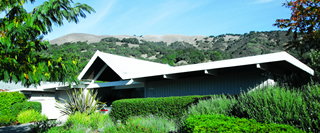New Faces for Old Roofs
 |
|
|
While there are a lot of ways to gain immediate pleasure by spending $15,000 to $30,000—perhaps in the form of a new car or an around-the-world cruise—they can’t compare to the long-term value of a reliable, leak-free, energy-efficient roof.
Although government-issued tax credits for new energy-efficient roofs expired in 2013, there are still plenty of benefits to installing a more efficient roof: reliability, a stable temperature inside your home, and lower utility bills.
But if you are shopping for a new roof, keep in mind: ‘cool roofs’—those that reflect sunlight and reduce the amount of heat conducted to the house below—are now a requirement in certain regions of California, according to California's energy code, the Title 24 Building Energy Efficiency Standards. It’s a matter of time, according to experts, before the rest of the state will follow suit.
Government organizations, roofers, and utility companies have long-touted the benefits of cool roofs, which can significantly lower cooling energy costs and increase the comfort level inside your home by reducing temperature fluctuations.
Heat reflection reduces costs
If a house doesn’t have air conditioning, a cool roof will help keep the building cooler in the summer and at a more constant temperature. If a cool-roofed residence does have air conditioning, then the AC equipment will not have to work as hard.
“Anyone installing a low-slope roof benefits from installing a cool roof,” says Trevor Leeds, president of Chandler’s Roofing, a single-ply roofing installer based in the Orange-Long Beach regions of Southern California. “By installing a roofing material that reflects heat away from the home, you reduce your energy costs and your cooling costs, and that can add up.”
 |
|
|
Because cool roofs save both energy and money, in October 2005 they were incorporated into the prescriptive requirements of Title 24. Back then, Title 24 required initial solar reflectance of 0.70 and initial thermal emittance of 0.75 only on low-sloped commercial buildings throughout the state.
Solar reflectance measures how much solar energy the roof surface reflects back into the atmosphere. In addition to that reflection, roofs also radiate, or emit, back into the atmosphere a portion of the solar energy that is initially absorbed and not reflected. Solar reflectance and thermal emittance are expressed on a scale from 0.0 to 1.0.
Since 2005, California’s Title 24 has slowly cranked up their reflectivity requirements. The new 2013 codes, which go into effect July 2014, require an aged SR of 0.63 and an aged TE of 0.75, or an aged solar reflectance index of 75. Research suggests that roofing materials become less efficient in their solar reflectance and emittance over time and with exposure to the elements, and this is measured by the ‘aged’ measure.
Title 24 now also requires cool roofs on flat and low-sloped residential buildings in Climate Zones ten through 15 and on commercial buildings throughout most of the state. These zones include Concord, Walnut Creek, and Sacramento. Cool-roof requirements are triggered when either 50 percent or more of the roof area or more than 1,000 square feet, whichever is less, is replaced.




